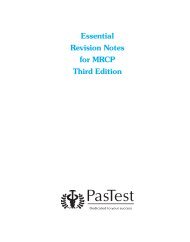Fast Track Surgery: General, Vascular and Urology - PasTest
Fast Track Surgery: General, Vascular and Urology - PasTest
Fast Track Surgery: General, Vascular and Urology - PasTest
- No tags were found...
You also want an ePaper? Increase the reach of your titles
YUMPU automatically turns print PDFs into web optimized ePapers that Google loves.
USING THIS BOOK AND STUDYING FOR SURGERYThis book was written for you, the medical student on surgical rotations,by registrars <strong>and</strong> senior house officers (people who are not too far offfrom where you are right now). Its aim is to serve as a summary ofcommon surgical conditions you are likely to come across during thattime. It serves as a rapid-access study aid <strong>and</strong> is not meant to be acomplete surgical text.<strong>Surgery</strong> is a logical <strong>and</strong> practical science, <strong>and</strong> studying it should be thesame. Ideally, after seeing a case on the ward, you should read about itextensively in your st<strong>and</strong>ard surgical text <strong>and</strong> then use this book torefresh <strong>and</strong> highlight salient points <strong>and</strong> concepts. Reading should bedone daily (or nightly!). The average surgical attachment isapproximately 10 weeks. That equates to 70 days. Reading an averageof 10 pages a day (approximately 1 hours worth of reading), <strong>and</strong> 20 aday on Saturday <strong>and</strong> Sunday mornings from a st<strong>and</strong>ard surgicaltextbook (<strong>and</strong> this one!), equals 900 pages by the end of the rotation:enough to give you a broad, sound base of surgical knowledge <strong>and</strong> stillleaving adequate time to go on take, <strong>and</strong> even squeeze in a social life(just about). Sorted!The book is designed in a question-<strong>and</strong>-answer type format, <strong>and</strong> makesuse of questions commonly asked on the wards, with the answers givenin the succinct <strong>and</strong> structured way they should be answered. Thequestions are largely derived from what the authors remember beingasked when they were medical students themselves. Applied anatomy isincluded where relevant (an essential survival tool in the operatingtheatre!). The book also makes use of tables <strong>and</strong> mnemonics whereappropriate, <strong>and</strong> gives management plans in list form as you might seewritten in patients’ notes. Blood investigations <strong>and</strong> radiology are listedwith explanations on why they are ordered, as the reasons usuallyevade medical students! Keep this book with you at all times duringyour clerkship <strong>and</strong> use it for a bit of cramming from it in your sparemoments on the wards. Its two-columned format makes it useful forrevision as the answers can be covered up while you test yourself withthe questions.3
















